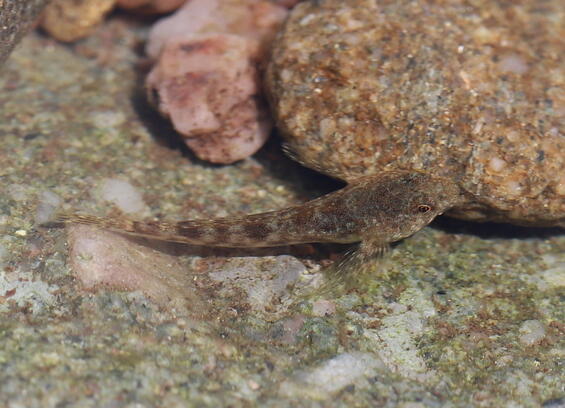- Scientific name: Cottus cognatus
- Species of Greatest Conservation Need (MA State Wildlife Action Plan)
Description

Slimy Sculpin (Cottus cognatus)
The slimy sculpin has a broad head, tapering body, large fanlike pectoral fins, a hooked preopercular spine, no scales, pelvic fins positioned under the anterior base of the pectoral fins, and soft, flexible fin spines. This species is mottled brown to gray dorsally with saddle-shaped blotches that sometimes extend onto the upper sides. Breeding males are darker, almost black above, with a bright orange border on their first dorsal fin. This is the only sculpin found in Massachusetts freshwaters. Another small sculpin, the grubby (Myoxocephalus aenaeus) is common in local marine waters, but never enters freshwater habitats. Slimy sculpin lack a swim bladder and live very close to the bottom even while feeding. The slimy sculpin is a relatively small fish; most adults are about 7.5 cm (3 in) long. Exceptional specimens may exceed 10 cm (4 in). Slimy sculpin can live up to 7 years.
Life cycle and behavior

Slimy sculpin feed primarily on bottom-dwelling invertebrates, particularly aquatic insect larvae and nymphs. Small crustaceans, fishes, and fish eggs are consumed in lesser amounts.
Spawning generally occurs in April or May. Male slimy sculpins defend a nest site, usually under overhead cover like stones or logs, and attract females to lay their eggs there. After attracting several females to lay eggs, and fertilizing those eggs, males will guard the nest until the eggs hatch.
Distribution and abundance
In Massachusetts, slimy sculpin are common and widely distributed in suitable coldwater habitats west of the Connecticut River. East of the Connecticut River, there are small, geographically isolated populations in the Millers, Chicopee, and Nashua River basins. In 1861, specimens were taken from the lower Merrimack near Lawrence, but this population is thought to have been extirpated.

Data from 1999-2024 from annual surveys.
Habitat

In Massachusetts, slimy sculpin are known only from high-gradient, rocky, clear, cold streams. In other parts of their range, they also inhabit cold-water lakes and low-gradient, spring-fed streams. In streams, slimy sculpin generally inhabit rocky riffles and runs. They lack a swim bladder and are generally poor swimmers so they tend to stay close to the bottom, generally hidden in the substrate.
Healthy habitats are vital for supporting native wildlife and plants. Explore habitats and learn about conservation and restoration in Massachusetts.
Threats
The continued presence of slimy sculpin in eastern Massachusetts depends on the protection of habitat adjoining hill-streams. Changes in water quality, possibly due to lingering effects of acid rain, have impacted a number of slimy sculpin populations. Activities, including those stemming from climate change, which increase turbidity or temperature are likely to have a negative impact on this species as well. As with all stream and river dwelling species, stream flow alteration is also a likely contributor to reduced resilience on the landscape. Increased flooding and drought will severely impact the amount of habitat available annually to slimy sculpin, especially in summer months when water temperature is critical to this obligate coldwater species. Their habitat has already likely been considerably reduced historically and climate change will impact additional habitat from both a hydrologic and temperature perspective.
Conservation
Not enough is known about slimy sculpin in Massachusetts waters to develop a species-specific management plan. They seem to be fairly common and widespread in suitable coldwater habitats in the western half of the state. It is anticipated that conservation and management initiatives targeting keystone species, such as brook trout, or broader ecosystem-based management objectives would also be indirectly beneficial to slimy sculpin. Slimy sculpin are an important indicator of high-quality coldwater habitat so additional resources aimed at more extensive monitoring of their abundance and distribution in relation to climate warming is warranted.
References
Karsten E. Hartel, David B. Halliwell, and Alan E. Launer. Inland Fishes of Massachusetts. Lincoln, Massachusetts: Massachusetts Audubon Society, 2002
Contact
| Date published: | April 10, 2025 |
|---|